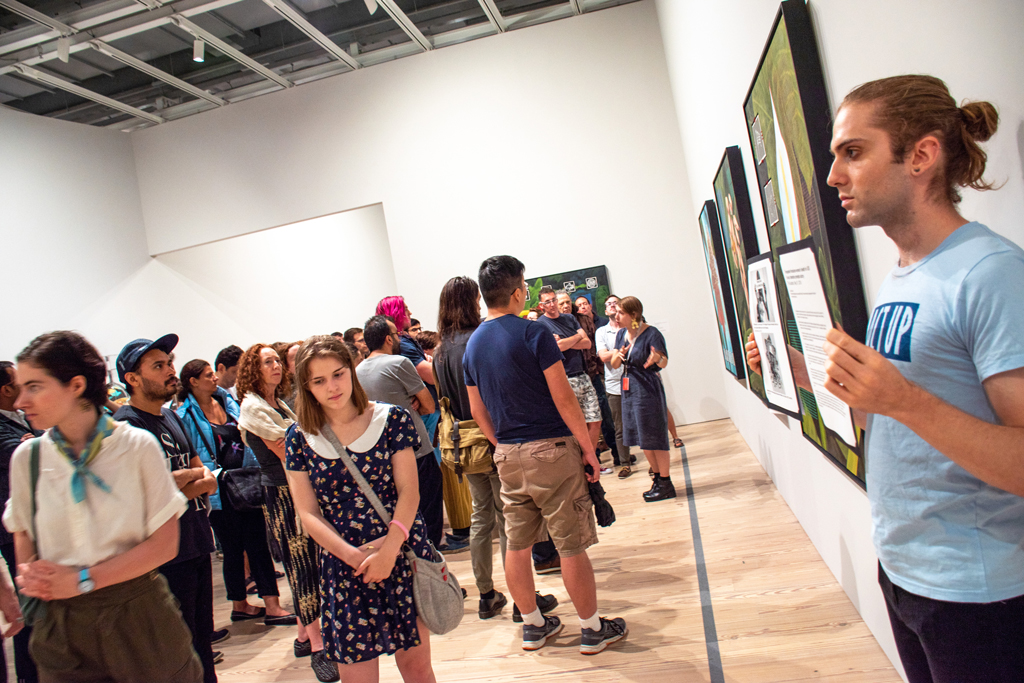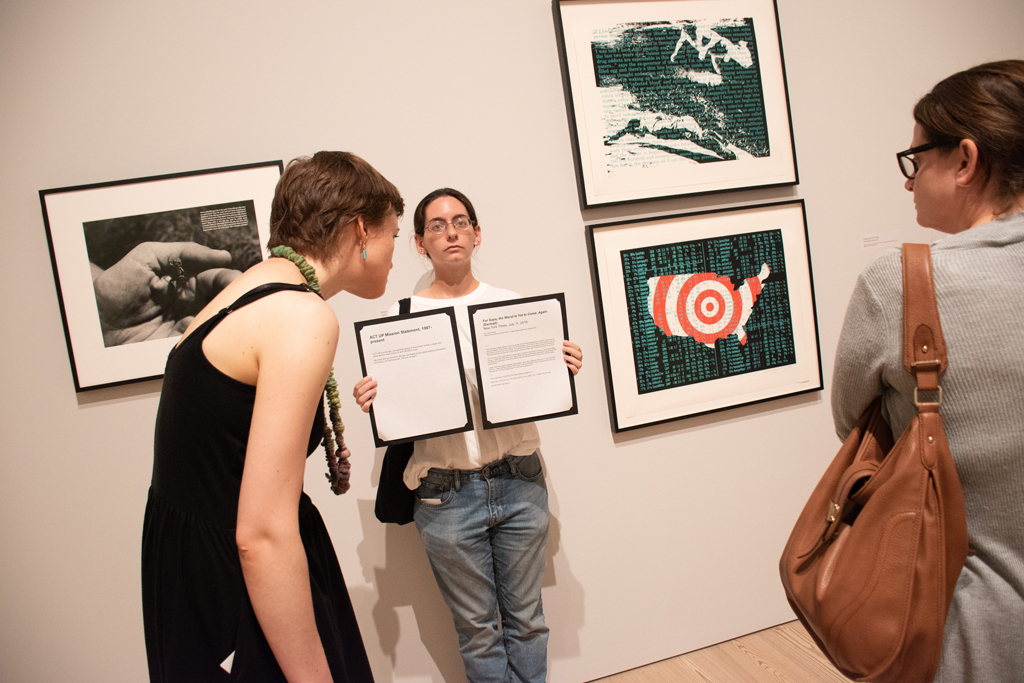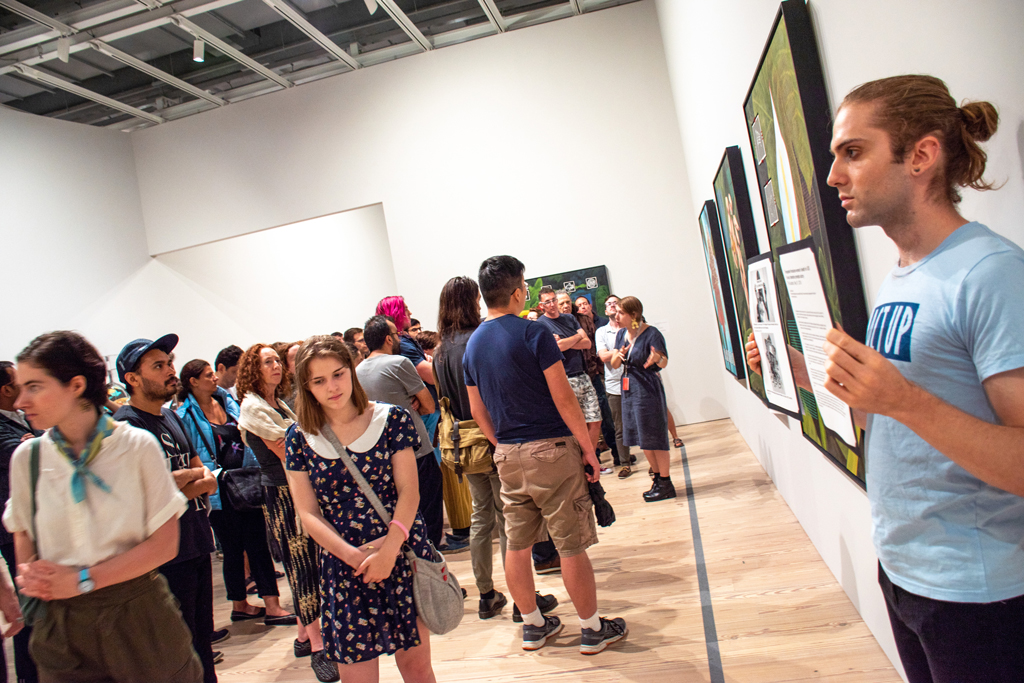[ad_1]

Members of ACT UP stage a protest at the Whitney Museum during its David Wojnarowicz exhibition on July 27, 2018.
MICHELLE WILD, SHUTTERBUGBOUDOIR.COM
On Friday evening, the New York chapter of AIDS Coalition to Unleash Power, more commonly known by its acronym, ACT UP, staged a protest-cum-performance at the Whitney Museum, alleging that the Manhattan institution’s current career retrospective of the late artist and writer David Wojnarowicz fails to connect his legacy of rageful AIDS activism to the ongoing battle against the epidemic.
The exhibition, titled “History Keeps Me Awake at Night” and curated by David Breslin and David Kiehl, opened earlier this month to rave reviews, with many publications running articles calling Wojnarowicz’s work particularly relevant to the present current era. Holland Cotter’s review in the New York Times carried the headline “He Spoke Out During the AIDS Crisis. See Why His Art Still Matters.”
Activists of the New York chapter of ACT UP, however, staged their protest in order to call attention to what the group sees as the exhibition’s historicizing of AIDS without addressing its relevance to the continued global AIDS pandemic. The protest follows a long line of actions the group undertook throughout the height of its membership in the late 1980s and early 1990s, which included protests and die-ins on Wall Street, at the Food and Drug Administration, and St. Patrick’s Cathedral.
In a statement, the Whitney detailed programming it has done and has planned that deal with current HIV/AIDS issues and said in part, “The more this vital subject can be brought front and center, the better. We completely agree that the AIDS crisis is not history.” (The full statement follows below.)
The idea for ACT UP to stage a protest at the Whitney was initiated by Ariel Friedlander, a 20-year-old college student at the University of Michigan, who joined the coalition earlier this summer. Friedlander visited the retrospective during a field trip for a photography course she took at the Brooklyn-based Pratt Institute this summer. In an interview with ARTnews, Friedlander recalled being upset and eventually crying during her visit to the exhibition, being moved both by the power of Wojnarowicz’s work and what she saw as the exhibition’s lack of mention of contemporary HIV/AIDS issues. Friedlander brought the idea of staging a protest at the Whitney to a recent ACT UP meeting, where it was considered and approved by the coalition’s current members.
“I realized I was mostly upset because I knew that people would walk past this exhibit and they’d think it’s beautiful and think it’s important but that they would think it was history, and the AIDS crisis is over,” Friedlander said by phone today. “But it’s not, and these issues that Wojnarowicz spoke about in his art are especially prevalent today in many ways concerning the AIDS epidemic. Once something is in a museum, it’s immediately memorialized, unless it is explicitly noted that these issues are going on today.”

Members of ACT UP stage a protest at the Whitney Museum during its David Wojnarowicz exhibition on July 27, 2018.
MICHELLE WILD, SHUTTERBUGBOUDOIR.COM
The action on Friday consisted around 12 group members holding up excerpts of recent news articles related to current HIV/AIDS issues, printed to mimic the format of wall text in Whitney exhibitions, in the galleries devoted to the retrospective, as well as those for “An Incomplete History of Protest,” a show of work from the permanent collection that includes a section on historical AIDS activism.
Among the news items in the posters were the recent death of Roxana Hernández, an HIV-positive trans woman who died while being held in a detention center by U.S. Immigration and Customs Enforcement, and a 2017 New York Times article by Linda Villarosa that details the harrowing statistics of new HIV contractions by black gay and bisexual men in the American South.
Each poster was meant to relate directly to the art in each gallery. Next to a 1990 screenprint titled Untitled (ACT-UP), by Wojnarowicz, toward the end of his exhibition, the coalition held its mission statement, and another flyer, related to the day’s action, was also displayed, noting that Wojnarowicz himself was an active member of ACT UP until his death in 1992, at the age of 37, and reading in part:
“AIDS is not history. The AIDS crisis did not die with David Wojnarowicz. . . . We are here tonight to honor David’s art and activism by explicitly connecting them to the present day. When we talk about HIV/AIDS without acknowledging that there’s still an epidemic – including in the United States – the crisis goes quietly on and people continue to die.”
Friedlander said that she and the other members staged the protest to honor Wojnarowicz and his legacy, so that he did not “die in vain,” and to remember that people continue to die each year from AIDS-related complications and continue to contract HIV. “Whenever we talk about AIDS and the artists and activists who were HIV-positive and who passed away from AIDS-related complications, it is our duty to carry on their legacy,” she said. “It’s an ongoing issue and we can’t memorialize or romanticize their stories. We have to put them into context or else their message is lost. Even if one person dies of AIDS, it is our responsibility to do better and to speak out for them and to find an end to the AIDS epidemic because we are talking about human lives. We are not just talking about paintings on a wall.”
When reached for comment on the protest, a Whitney spokesperson sent the below statement, asking that it be reproduced in full:
We are honored to present the work of David Wojnarowicz in our current retrospective and embrace the opportunity to bring more awareness to the ongoing AIDS pandemic. The more this vital subject can be brought front and center, the better. We completely agree that the AIDS crisis is not history. Part of our mission in mounting this exhibition is to make sure the history of the AIDS crisis figures centrally in American (and international) history so that it might inform present and future action. We have made an effort to frame AIDS as a current and ongoing crisis in a number of programs, including the July 13 symposium (the opening day of our exhibition) entitled “Visual Arts and the AIDS Epidemic” and in a September 7 reading that is being co-organized with Visual AIDS. Both include HIV+ artists and activists. Our educators and docents speak about the ongoing AIDS pandemic in tours in the galleries. We have a series of scheduled programs on Saturday afternoons throughout the exhibition that address “Queer Art and Activism.” Perhaps our position is expressed most clearly in the following wall text that is part of our exhibition “An Incomplete History of Protest” which is now on the sixth floor and has been on view for the past year: “As we continue to live with such loss, and AIDS still affects individuals and communities in the United States and globally, the rallying cry of ACT UP (AIDS Coalition to Unleash Power) resounds today: the AIDS crisis is not over.”
Friedlander said she hopes the protest will open up a dialogue with the Whitney, not only about how it presents AIDS and its history, but also in terms of learning about the revenue it earns related to AIDS art and the work of Wojnarowicz, from museum admission, the sale of the show’s catalogue, and merchandize sold in its store, and whether any of those funds are directed to AIDS nonprofits. She also said that she believed that the museum should do more community outreach to living queer artists and activists, beyond a few programs and its weekly free admission nights.
“It’s easy to take someone who’s already passed away and project a narrative onto them and profit off of them,” Friedlander said. “People see what the Whitney is doing as very neutral and that it’s not their duty to connect AIDS artworks to contemporary AIDS issues, but I don’t see it as neutral because when you put these artworks up in a museum and you talk about these issues as if they were all in the ’80s, how are people supposed to know that these issues are still going on? That further contributes to the stigma that we still see today when it comes HIV/AIDS.”
“The Whitney should feel in the goodness of their heart that they have to do better and that they have to educate their visitors,” she added.
[ad_2]
Source link

